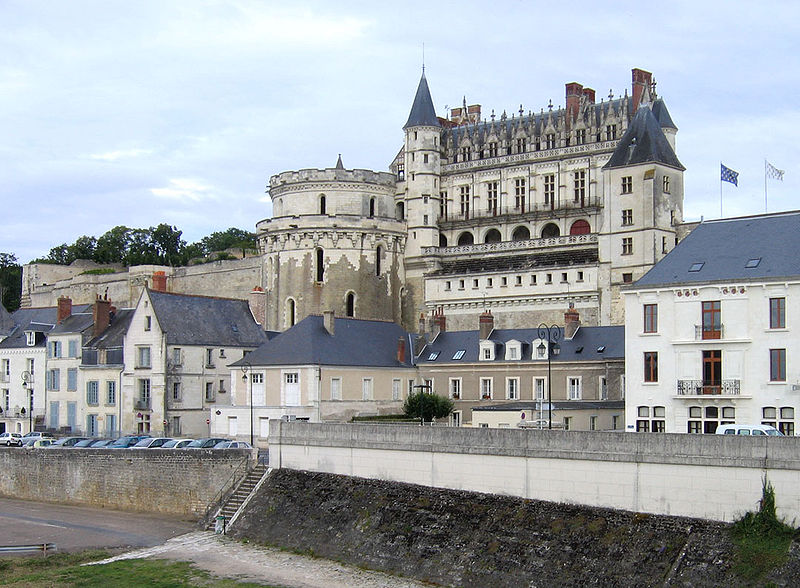Château d'Amboise
The Amboise castle is placed on a hilltop overlooking the confluence of the Loire and the Amasse rivers. This site was fortified already in Celtic times. In 503 A.D. Amboise entered history when Clovis, the first King of France, met there with Alaric, King of the Wisigoths. The family of Amboise gradually established a stronghold at this site, and the castle started to take form. In 1431, Louis d'Amboise was condemned to death for treason by King Charles VII, and the castle was taken over by the crown. Charles VII had established himself in Bourges, also in the Loire region, and thereby marked the first presence of the kings of France in the Loire Valley. His son, Charles VIII, was the king who stayed there the longest. He stayed there daily during his reign, and died there in 1498 when his head collided violently with a lintel over a door. His successor, Louis XII, married Charles VIII's wife - Anne of Brittany - thus securing the Duchy of Brittany for the French crown. Louis XII preferred to stay at the Blois castle, but he completed the building works at Amboise that Charles VIII had started.
Francis of Angoulême, a nephew of King Louis XII, meanwhile lived at Amboise, Louis XII left no heir to the throne when he died in 1515. His nephew Francis then became king, under the name Francis I. He spent much time at Amboise and also brought Leonardo da Vinci there to organise fire works and other festivities. Francis I wanted to find a way to make peaceful coexistence between the emergent protestant movement and the catholics, but a big protestant provocation organised simultaneously in several cities by Antoine Harcourt in 1534 undermined Francis I's efforts. The son of Francis I, Henry II, married Catherine of Medicis, a strong-willed catholic from the Medici family of Florence. On Henry II's death the situation gradually worsened. Francis II had inherited the throne from his father Henry II, and married the catholic Mary Stuart when he was 15 years old. The following year, in 1560, protestant conspirators tried to remove the young King Francis II from the influence of Mary's uncles, the Guises. The conspirators were caught, and subsequently hanged from the balcony of the Amboise castle for everybody to see - as a warning. This important event was followed by an even more important one, when all the protestant nobles were invited into an ambush at what was supposed to be a festive occasion of reconciliation - the St. Bartholomew's Day in 1572. On that occasion, at the Amboise castle, most of the protestant nobility was killed in a great massacre. This dramatic climax of the religious conflicts in France was later followed by the Edict of Nantes in 1598, which ensured liberty of faith in France. This edict was made by King Henry IV, who had acceeded to the throne after none of Catherine's three sons had produced a heir to the throne.
You can read more here.
Francis of Angoulême, a nephew of King Louis XII, meanwhile lived at Amboise, Louis XII left no heir to the throne when he died in 1515. His nephew Francis then became king, under the name Francis I. He spent much time at Amboise and also brought Leonardo da Vinci there to organise fire works and other festivities. Francis I wanted to find a way to make peaceful coexistence between the emergent protestant movement and the catholics, but a big protestant provocation organised simultaneously in several cities by Antoine Harcourt in 1534 undermined Francis I's efforts. The son of Francis I, Henry II, married Catherine of Medicis, a strong-willed catholic from the Medici family of Florence. On Henry II's death the situation gradually worsened. Francis II had inherited the throne from his father Henry II, and married the catholic Mary Stuart when he was 15 years old. The following year, in 1560, protestant conspirators tried to remove the young King Francis II from the influence of Mary's uncles, the Guises. The conspirators were caught, and subsequently hanged from the balcony of the Amboise castle for everybody to see - as a warning. This important event was followed by an even more important one, when all the protestant nobles were invited into an ambush at what was supposed to be a festive occasion of reconciliation - the St. Bartholomew's Day in 1572. On that occasion, at the Amboise castle, most of the protestant nobility was killed in a great massacre. This dramatic climax of the religious conflicts in France was later followed by the Edict of Nantes in 1598, which ensured liberty of faith in France. This edict was made by King Henry IV, who had acceeded to the throne after none of Catherine's three sons had produced a heir to the throne.
You can read more here.
